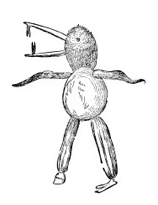Did you start cutting up and splicing images from famous paintings as a way to insert yourself into an imaginary community—one that is both internal and very real at the same time?
Yes. If I am answering the question right, it is like creating a timeless world. I can go into Vermeer's studio and be there with him then and now. One of the reasons for not using clothes was the idea that there is no time costume. It destroys time. And it does it in a unique place, which is now my place. This is an alien concept to photography, where you are usually capturing someone else's place or the place around you. The cutting out actually started when I was a little kid during World War II. I loved soldiers and things like that—playing with little soldiers. I always had to have the little English soldiers that looked precise and very real, whereas the ten-cent-store ones were all featureless blobs. When the war occurred they stopped making them, but they did put out great big books with whole army units or something and you had to cut all the soldiers out. I would buy those and make entire regiments of cut-out people. Tiny things, but maybe a lot of the urge to cut out does have a relationship to that. I also had a big toy garage set that you drove your little toy car into—you turned a crank, and it would take the cars up to different floors. I would fill that with the soldiers. It would be a little world and when I got sick of it . . . I would bomb it.
Your work seems engaged with an entire community of artists—all having a conversation that crosses generations and subject matter. For instance, Auden wrote the introduction to Cavafy's collected poems; Benjamin Britten then did an opera with Auden's libretto; and you have taken the figure of Benjamin Britten and created a series.
One of the things that attracted me to Britten was his attraction to all sorts of works—"Billy Bud," "Death in Venice," "The Illuminations"—all these different works and artists that I was attracted to. That made me like him, in a sense. When I was doing the series on him, I was cross-referencing. I'd be making my picture, but it would be about Benjamin Britten's presentation of Melville's story. So, yes, there is that conversation. There is also an inner connection. I become each one of these people in my imaginary worlds. In terms of subject, Genet was my first interest. This is before I was using the camera. I couldn't buy his books, so I'd go to the library and take out their editions in French. Then I'd translate as much as I could. Finally a piece of his was published in English somewhere, and I tried illustrating it. This was in 1976. My next interest was Cavafy. I didn't have the money in the beginning to buy Cavafy's books, so I would take them out of the library and read them and copy the poems. I'd seen a book by Joseph Cornell in which he'd taken a French dictionary and pasted little things all through the book. So I found a Greek language lesson book, and I pasted in these images of ancient Greek statues—cyanotypes that came from an art history course text—along with inserts of my copies of the poems. I would write the poem and place the pictures. The next step in these books was to buy Cavafy's biography. I left his picture on the first page, but from that point on I substituted images of myself for him. I kind of take over the identity of these poets in my mind. I made Cavafy myself in that sense, too.
To read the rest of this interview, please click here to purchase JUBILAT 2



